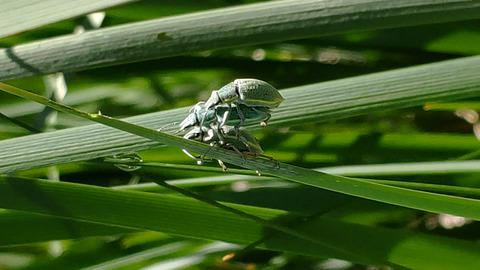当前位置:
X-MOL 学术
›
J. Anim. Ecol.
›
论文详情
Our official English website, www.x-mol.net, welcomes your
feedback! (Note: you will need to create a separate account there.)
Trial marriage model – female mate choice under male interference
Journal of Animal Ecology ( IF 3.5 ) Pub Date : 2020-05-14 , DOI: 10.1111/1365-2656.13240 Meng-Yao Li 1 , Zhuo-Song Geng 1 , Peng Liao 1 , Xiao-Yang Wang 1 , Tian-Chang Yang 1 , Jing-Yuan Wang 1 , Dan-Dan Wang 1 , Li-Fang Gao 1 , Bo Du 1
Journal of Animal Ecology ( IF 3.5 ) Pub Date : 2020-05-14 , DOI: 10.1111/1365-2656.13240 Meng-Yao Li 1 , Zhuo-Song Geng 1 , Peng Liao 1 , Xiao-Yang Wang 1 , Tian-Chang Yang 1 , Jing-Yuan Wang 1 , Dan-Dan Wang 1 , Li-Fang Gao 1 , Bo Du 1
Affiliation

|
In sexually reproducing animals, the process of mate choice by females is often mixed with the process of male-male competition. Current models of female male choice focus mainly on how females identify the higher quality of males, but neglect the effect of male-male competition on the mate choice of females. Therefore, it remains controversial what is the relative importance of two processes in forming a social bond. We propose a new "trial marriage" model for females' mate choice. The model assumes that females unconditionally accept any male they first encounter as their mating partner, and then conditionally switch mates to a new male of higher quality than their current partner when male-male competition occurs. This model was tested in the green weevil, Hypomeces squamosus, by exploring how females switched mates when males' mating interference was experimentally induced. The likelihood that females switched mates, as well as their conditional acceptance criteria of a new mate, was both raised with the intensity of males' mating interference that was manipulated in an enhanced encounter rate experiment, and in male introduction or stepwise removal experiments. These experimental findings confirm that a "trial marriage" strategy occurs during females' mate choice. Compared with other strategies, it is more beneficial for females to choose a better mate without paying the costs of identifying males as suggested by the "trial marriage" strategy. More importantly, by using the current partner quality as the conditional acceptance threshold of new mates, females can choose better males in future encounters with potential mates. In the green weevils, males' preference for larger females and the higher possibility of the largest male winning an interference are mixed together when males' mating interference reaches a higher intensity. Therefore, the consequence of a male interference will determine which male could be chosen by a female. Under this condition, conditional acceptance of the winner becomes the most beneficial strategy of females in choosing their mates. We thus suggest that the "trial marriage" strategy would be more efficient when males' mating interference becomes the determinant factor of females' mate choice.
中文翻译:

试婚模式——男性干预下的女性择偶
在有性繁殖的动物中,雌性选择配偶的过程往往与雄性竞争的过程混合在一起。目前的雌雄选择模型主要关注雌性如何识别雄性较高的品质,而忽略了雄性竞争对雌性择偶的影响。因此,两个过程在形成社会联系中的相对重要性仍然存在争议。我们提出了一种新的女性择偶“试婚”模式。该模型假设雌性无条件地接受他们第一次遇到的任何雄性作为他们的交配伙伴,然后在发生雄性竞争时有条件地将配偶转换为质量比当前伴侣更高的新雄性。该模型在绿色象鼻虫 Hypomeces squamosus 中进行了测试,研究对象是雄性时雌性如何交换配偶。交配干扰是通过实验诱导的。雌性交换配偶的可能性,以及他们对新配偶的有条件接受标准,都随着雄性交配干扰强度的增加而增加,这种干扰在增强的相遇率实验和雄性引入或逐步去除实验中被操纵。这些实验结果证实,在女性选择配偶期间会出现“试婚”策略。与其他策略相比,“试婚”策略建议女性选择更好的配偶,而无需支付识别男性的成本。更重要的是,通过使用当前伴侣质量作为新伴侣的条件接受阈值,雌性可以在未来与潜在伴侣的相遇中选择更好的雄性。在绿色象鼻虫中,当雄性的交配干扰达到更高的强度时,雄性对体型较大的雌性的偏好和最大的雄性赢得干扰的可能性较高。因此,男性干预的后果将决定女性可以选择哪个男性。在这种情况下,有条件地接受胜者成为雌性选择配偶的最有利策略。因此,我们认为,当男性的交配干扰成为女性择偶的决定因素时,“试婚”策略会更有效。男性干预的结果将决定女性可以选择哪个男性。在这种情况下,有条件地接受胜者成为雌性选择配偶的最有利策略。因此,我们认为,当男性的交配干扰成为女性择偶的决定因素时,“试婚”策略会更有效。男性干预的结果将决定女性可以选择哪个男性。在这种情况下,有条件地接受胜者成为雌性选择配偶的最有利策略。因此,我们认为,当男性的交配干扰成为女性择偶的决定因素时,“试婚”策略会更有效。
更新日期:2020-05-14
中文翻译:

试婚模式——男性干预下的女性择偶
在有性繁殖的动物中,雌性选择配偶的过程往往与雄性竞争的过程混合在一起。目前的雌雄选择模型主要关注雌性如何识别雄性较高的品质,而忽略了雄性竞争对雌性择偶的影响。因此,两个过程在形成社会联系中的相对重要性仍然存在争议。我们提出了一种新的女性择偶“试婚”模式。该模型假设雌性无条件地接受他们第一次遇到的任何雄性作为他们的交配伙伴,然后在发生雄性竞争时有条件地将配偶转换为质量比当前伴侣更高的新雄性。该模型在绿色象鼻虫 Hypomeces squamosus 中进行了测试,研究对象是雄性时雌性如何交换配偶。交配干扰是通过实验诱导的。雌性交换配偶的可能性,以及他们对新配偶的有条件接受标准,都随着雄性交配干扰强度的增加而增加,这种干扰在增强的相遇率实验和雄性引入或逐步去除实验中被操纵。这些实验结果证实,在女性选择配偶期间会出现“试婚”策略。与其他策略相比,“试婚”策略建议女性选择更好的配偶,而无需支付识别男性的成本。更重要的是,通过使用当前伴侣质量作为新伴侣的条件接受阈值,雌性可以在未来与潜在伴侣的相遇中选择更好的雄性。在绿色象鼻虫中,当雄性的交配干扰达到更高的强度时,雄性对体型较大的雌性的偏好和最大的雄性赢得干扰的可能性较高。因此,男性干预的后果将决定女性可以选择哪个男性。在这种情况下,有条件地接受胜者成为雌性选择配偶的最有利策略。因此,我们认为,当男性的交配干扰成为女性择偶的决定因素时,“试婚”策略会更有效。男性干预的结果将决定女性可以选择哪个男性。在这种情况下,有条件地接受胜者成为雌性选择配偶的最有利策略。因此,我们认为,当男性的交配干扰成为女性择偶的决定因素时,“试婚”策略会更有效。男性干预的结果将决定女性可以选择哪个男性。在这种情况下,有条件地接受胜者成为雌性选择配偶的最有利策略。因此,我们认为,当男性的交配干扰成为女性择偶的决定因素时,“试婚”策略会更有效。











































 京公网安备 11010802027423号
京公网安备 11010802027423号